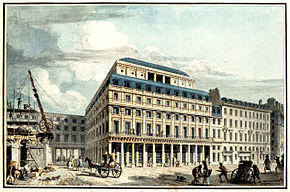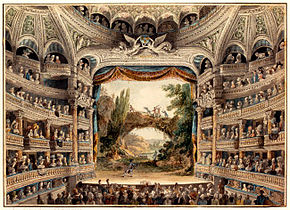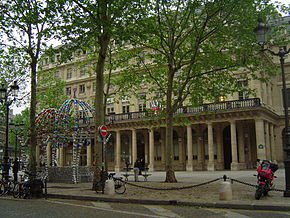- Comédie-Française
-
Comédie-Française 
Exterior of the Comédie-FrançaiseAddress 2 rue de Richelieu
1st. ParisCity Paris Architect Victor Louis Capacity 1100 Opened 1799 Rebuilt 1900 Previous names Théâtre-Français
Théâtre-Nautique
théâtre de la Républiquewww.comedie-francaise.fr The Comédie-Française (French pronunciation: [kɔmedi fʁɑ̃sɛz]) or Théâtre-Français (IPA: [teatʁ fʁɑ̃sɛ]) is one of the few state theaters in France. It is the only state theater to have its own troupe of actors. It is located in the 1st arrondissement of Paris.
The theatre has also been known as the Théâtre-Nautique, the théâtre de la République and La maison de Molière. It inherited the latter name (English: House of Molière) along with the dramatic venue of the best-known playwright associated with the Comédie-Française, Molière. He was considered the patron of French actors. He died seven years before “La maison de Molière” was rechristened the “Comédie-Française,” and it continued to be known popularly by the former name even after the official change of name.[1]
Contents
History
The Comédie-Française was founded by a decree of Louis XIV on 24 August 1680 to merge the only two Parisian acting troupes of the time, the troupe of the hôtel Guénégaud and that of the hôtel de Bourgogne. On the death of Molière, the troupe of the hôtel Guénégaud had formed by a merger of the Théâtre du Marais and the Troupe de Molière.[2] In 1680, the repertoire consisted of the collection of theatrical works by Molière and Jean Racine, along with a few works by Pierre Corneille, Paul Scarron and Jean Rotrou. Two years after the amalgamation of the dramatic companies, they received a royal grant of 12,000 livres per year; and seven years later they took as their name their present designation of “players of the Comédie Française.”[1]
Its first building was housed at the Hôtel de Guénégaud. The Hôtel de Guénégaud Theatre was Molière's dramatic institution, and had originally been an old theatre where miracle plays had been presented as early as 1543. Thus the Comédie-Française may be said to have an unbroken tradition reaching back to the days of Molière, and to have had theatre connections for more than a century previous to the death of the great dramatist in 1673.[1]
On the performance of Joseph Chénier's anti-monarchical play Charles IX in 1789, violent political discussions arose among the performers, and ultimately they split into two sections: the Republican party, under the young tragedian Talma, establishing a new theatre under the name “Théâtre de la République,” on the site of the present building in the Rue de Richelieu; while the Royalist section took the title “Théâtre de la Nation.”[2] On 3 September 1793, during the French Revolution, the Théâtre de la Nation was closed by order of the Committee of Public Safety for putting on the allegedly seditious play Pamela, and the actors were imprisoned though gradually released later. On 31 May 1799, the new government made the salle Richelieu available and allowed the actors to reconstitute the troupe.
The Comédie-Française today has a repertoire of 3,000 works and three theaters in Paris (salle Richelieu, next to the Palais Royal; théâtre du Vieux-Colombier; Studio-Théâtre).
Theater buildings
The Comédie-Française has had several homes since its inception. In 1689, it was established across from the café Procope. The Odéon was designed by architects Marie-Joseph Peyre (1770–1843) and Charles De Wailly (1730–1798). From 1770 to 1782, the Comédie had quarters in the royal palace of the Tuileries.[1] Since 1799, the Comédie-Française has been housed in the salle Richelieu (architect Victor Louis) at 2, rue de Richelieu. This theater was enlarged and modified in the 1800s, then rebuilt in 1900 after a severe fire.
Theatrical troupe
Main article: Sociétaires of the Comédie-FrançaiseThe membership of the theatrical troupe is divided into “sociétaires” and “pensionnaires.” The former are regular members of the organization and as such receive a pension after 20 years of service, while the latter are paid actors who may, after a certain length of service, become “sociétaires.” The names of nearly all the great actors and dramatists of France have, at some time in their career, been associated with that of the Comédie-Française.[1]
Administrators of the Comédie-Française
Main article: Administrators of the Comédie-FrançaiseThe chief administrator of the Comédie-Française has been given the title administrateur général since Simonis' term of 1850. Before that, a variety of titles were given.
References
- ^ a b c d e
 "Comédie Française". Encyclopedia Americana. 1920.
"Comédie Française". Encyclopedia Americana. 1920. - ^ a b
 "Comédie Française". New International Encyclopedia. 1905.
"Comédie Française". New International Encyclopedia. 1905.
External links
Categories:- 1680 establishments
- Theatres in Paris
- Comedy venues
- National theatres
- 1st arrondissement of Paris
- Comédie-Française
- Theatre companies in France
- ^ a b c d e
Wikimedia Foundation. 2010.



